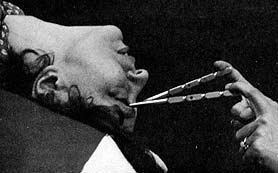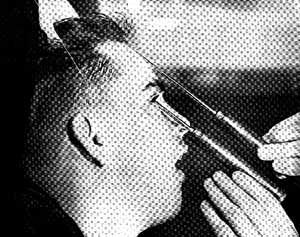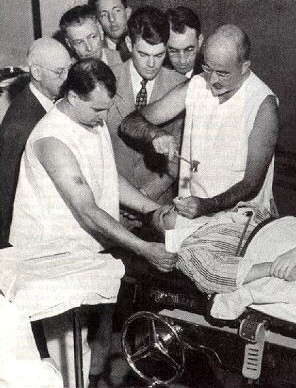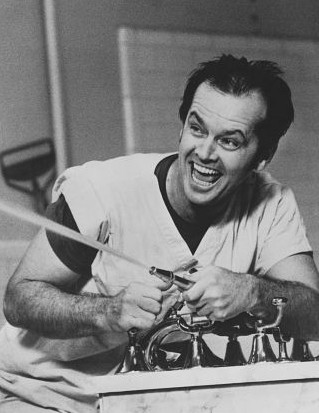|
Rotten Library > Medicine > Lobotomy
Lobotomy There's a Monty Python routine in which a simpleton goes to a brain specialist (also a simpleton), with a complaint: "My brain hurts!" The specialist gropes the man's head for a moment, then pronounces his diagnosis: "It'll have to come out!"
There's a Monty Python routine in which a simpleton goes to a brain specialist (also a simpleton), with a complaint: "My brain hurts!" The specialist gropes the man's head for a moment, then pronounces his diagnosis: "It'll have to come out!" Lobotomy is the practice of surgically removing parts of the brain as a treatment for the thoughts housed within. Even very primitive societies were quick to realize the obvious fact that the brain is the source of all evil. For centuries, however, brain surgery consisted of little more than taking a drill to someone's skull in order to let out all the pressure. The lobotomy was born in 1890, when a sick fuck named Friederich Golz sliced the frontal lobes out of his dogs' brains -- just to see what would happen. It turned out that the dogs were rendered much less aggressive. Instead of being hauled in for animal cruelty, Golz presented his findings. Needless to say, it took about five minutes for someone to try the technique out on humans. Swiss madhouse administrator Gottlieb Burkhardt treated six schizophrenic patients with the procedure. Sure enough, some of them became calmer. Two of them became so calm, in fact, that they were dead. This success was not much appreciated by the respectable scientists of the day, and Burkhardt received the ultimate punishment reserved for those who play God with human lives... a very stern talking-to.
A team of Portuguese doctors led by Egas Moniz refined the concept by returning to the aforementioned drill, but this time targeting specific nerve connections (rather than just letting the evil spirits out). They cut the connections between the frontal cortex and the thalamus, which is the brain's Grand Central Station for processing sensory input. The process was tried on humans, successfully in some cases, but without effect in others. Nevertheless, the discovery netted Moniz a Nobel Prize and inspired doctors all around the world to begin slicing up the brains of psychiatric patients like they were so much lunchmeat. From the 1930s through the 1950s, lobotomies were all the rage. It took an American, Dr. Walter Freeman, to revolutionize the procedure by making it quick and easy.
World War II caused a huge surge in psychiatric patients, and the easy fix had never looked better. Additionally, a growing body of psychiatrists believed lobotomy might be an effective way to treat such "psychiatric disorders" as Communism, homosexuality, nymphomania and general godlessness. In 1949, about 5,000 lobotomies were performed in the U.S. Some estimates place the total number of lobotomies performed in the U.S. from the 1930s through the 1950s as high as 50,000. From the 1940s through the end of the 1950s, at least 10,000 more lobotomies were performed in England, and tens of thousands more were performed worldwide. In Sweden, 4,500 people were lobotomized against their will, including children, between 1944 and 1963. John F. Kennedy's sister Rosemary received one of Freeman's ice-pick lobotomies, resulting in a severe mental impairment that left her paralysed, incoherent, and incontinent. According to some accounts, Rosemary had suffered from a mild mental retardation, which the lobotomy was supposed to fix. Others claim Rosemary wasn't even mentally ill to begin with, but simply a wild child, and her father Joe thought that involuntarily lobotomizing a 23-year-old was good parenting technique. Another of Freeman's patients was up-and-coming young actress Frances Farmer, considered by many to be "the next Garbo". After being arrested for disorderly conduct and subsequently stigmatized as a Communist sympathizer, Farmer was involuntarily institutionalized and progressively treated with every failed snake-oil psychiatric technique known to science in the 1940s.
Instead, she had the "good fortune" to remember her torturous asylum ordeals, even as she spent the rest of her short life battling psychiatric traumas far, far worse than the run-of-the-mill neuroses that landed her in the asylum to begin with. Freeman and his ice pick alone performed more than 3,000 lobotomies, until his surgical privileges were revoked after the death of a patient during the '60s. Unfortunately for the good doctor, as the sample of lobotomy patients grew, discerning scientists were able to spot an emerging trend... namely, that all these lobotomies weren't actually helping patients that much. One study found that only 40 percent of lobotomy patients had been "cured" by the procedure, with the rest showing little or no change. Something like one in 20 lobotomy patients simply died. These appear to have been generous figures in a number of ways. For one thing, it's not at all clear that the lobotomy was what helped the 40 percent who showed dramatic improvement after the surgery. For another, the study used only general terms to talk about the remaining 60 percent, glossing over such issues as the exact definitions of mental and behavioral impairment.
During the 1960s, new anti-psychotic drugs began to emerge on the scene. Although they too often had only spotty success rates, you could actually stop an antipsychotic drug regimen. A lobotomy, on the other hand, was an irreversible procedure -- damage to neural tissues almost never heals. In 1962, former psychiatric ward orderly Ken Kesey published One Flew Over the Cuckoo's Nest, a searing indictment of American mental health practices including lobotomy and electroshock therapy, an equally pointless treatment in most cases. With the tide of public opinion turning sharply against the practice, the number of lobotomies performed in the U.S. dropped dramatically through the 1960s and fell almost completely out of favor by the 1970s. Today, the procedure has been almost completely discredited and abandoned in the Western world. Only a handful of lobotomies are performed in the U.S. each year, most of which involve laser microsurgery rather than ice picks. Most U.S. states have today totally banned involuntary lobotomies, but there is no federal statute on the topic, so check your jurisdiction if you want to be certain there isn't an ice pick out there with your name on it.
|
 The technique languished for several decades, until a fresh round of animal torture, this time on chimps, revealed that lobotomies were fairly effective if you didn't go hacking around willy-nilly, but focused on the frontal and prefrontal lobes.
The technique languished for several decades, until a fresh round of animal torture, this time on chimps, revealed that lobotomies were fairly effective if you didn't go hacking around willy-nilly, but focused on the frontal and prefrontal lobes.  You may have heard reference to someone performing a lobotomy with an ice pick and assumed it was a joke. Unfortunately, it was not. Freeman's technique was to stick an icepick into the brain through the eye socket, then hacking the frontal lobe free by swirling it around in there.
You may have heard reference to someone performing a lobotomy with an ice pick and assumed it was a joke. Unfortunately, it was not. Freeman's technique was to stick an icepick into the brain through the eye socket, then hacking the frontal lobe free by swirling it around in there.  During a decade spent in and out of institutions, Farmer was subjected to barbarous treatment, some medical and some simply abusive. Finally, Freeman came calling with his ice pick in hand. (There is some controversy about whether or not Freeman actually used the ice pick on Farmer, but she was definitely one of his patients, and he was a bit of a one-trick pony.) Farmer fared better than Rosemary Kennedy... arguably. She didn't end up a vegetable.
During a decade spent in and out of institutions, Farmer was subjected to barbarous treatment, some medical and some simply abusive. Finally, Freeman came calling with his ice pick in hand. (There is some controversy about whether or not Freeman actually used the ice pick on Farmer, but she was definitely one of his patients, and he was a bit of a one-trick pony.) Farmer fared better than Rosemary Kennedy... arguably. She didn't end up a vegetable.  Over the course of various studies, the 40 percent figure held up (within a range from 30 to 50 percent) as the "best case" success rate for lobotomies, while stories of severe brain damage began to mount.
Over the course of various studies, the 40 percent figure held up (within a range from 30 to 50 percent) as the "best case" success rate for lobotomies, while stories of severe brain damage began to mount.